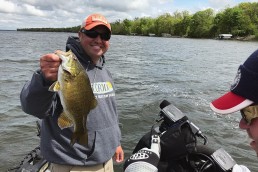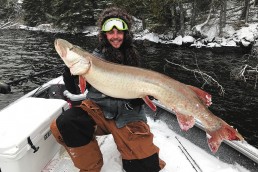Tony Roach Discusses the Nation’s No. 1 Smallmouth Fishery: Lake Mille Lacs
SHARE THIS POST
Bassmaster recently rated central Minnesota’s Lake Mille Lacs as the nation’s “No.1 smallmouth fishery.” Having fished this lake for decades, I couldn’t agree more. Here, MWO contributor and Mille Lacs fishing guide Tony Roach tells us how to catch the monster smallmouths that have put the lake “on the map” with bassheads nationwide, quickly turning this fishing-centric destination into a “must-visit” for anglers.
MidWest Outdoors: Tony, What makes Mille Lacs such a special smallmouth fishery?
Tony Roach: Well, it’s been a best-kept secret with Minnesota bass anglers for years. And obviously now with B.A.S.S. and many media outlets including MidWest Outdoors highlighting what an incredible fishery this is, it’s been great to see the influx of tourism from out-of-state folks. They’re fishing here and seeing what huge bass the lake produces. The nice thing about Mille Lacs is that we don’t have isolated habitat just in one corner of the lake; great fishing spots are all over. There’s unbelievably good bass habitat everywhere—huge boulder fields, shallow rock reefs connected to shoreline, isolated offshore reefs, weedlines and gravel bars. There are underwater points, some of which extend a mile or more out into the lake from the shore. Fishermen aren’t restricted to just casting along a shoreline or one key area that produces fish because there is good water all over the lake.
MWO: Many bass anglers are accustomed to standing on the trolling motor and working their way down a stretch of shoreline. It’s a great way to catch fish, but often the water out from the shoreline in this scenario is deep—the larger reservoir systems especially offer little in terms of bass-holding structure other than the extensive shorelines, endless numbers of channel cuts and some extended underwater points. Lots of water to cover, but it all looks the same. Lake Mille Lacs offers a diversity of structure and fishing options.
Roach: One key element about Mille Lacs is water clarity. It’s a very clear body of water. The lake was formed by glacial melting at the end of the Ice Age that left piles of rock of various sizes that was pushed into all kinds of ridges and formations all over, especially along the shorelines. There are spots with monster boulders and really good rock outcroppings with steeper breaks on some of these offshore structural elements. A lot of the reefs top out at 6-10 feet below the surface but offer lots of quality smallmouth habitat in the 10- to 20-foot depths. You don’t want to zoom up on these offshore reefs and get too close with the boat. I stop well away from them and start casting around the steeper, deeper edges first. I want to locate fish without driving my boat all over the structure. Many of these reefs have a very distinct transition where the rock ends and the mud basin begins. And while there are times when the bass are feeding heavily and moving around all over the reef, more times than not the bass will congregate on certain sections of the reef, not the whole thing. They’ll group up on perhaps on one, two, or three of the distinct edges of that structure, rather than scattering all over the reef. In that clear water, getting too close with the boat can spook a school. By approaching stealthily, rather than dropping the trolling motor and power-fishing all over the reef, you find that school and either Spot-Lock or just hover near them and keep casting. Wind or a congregation of baits can create these spot-specific locations, but often it’s the structure itself: a collection of larger boulders or a particularly steep edge that gathers those fish. When you find that, you catch bass.
MWO: Talk about the primary depths where you find Mille Lacs smallmouths holding in August.
Roach: You’ll have distinct groupings of fish based on a variety of factors. Lake Mille Lacs has a very high crayfish population. When they come in shallow and are molting in August, even though the lake surface temperature is at its highest the bass will move very shallow to feed on craws. You’ll be able to catch lots of bass in super-shallow water at times—I’m talking 2-3 feet deep. When the crayfish aren’t in shallow water, the bass slide right back to deeper, cooler water. If you’re coming to Mille Lacs to fish bass, start shallow, but if you’re not catching then move right away to those deeper edges and you’ll contact fish. By deeper edges, I mean the 12- to 18-foot range that’s adjacent to that same shallow rock structure. If you can find areas with bigger boulders mixed in, that’s even better.
MWO: Tell us your preferred tactics for catching these bass.
Roach: Drop-shotting is my number one go-to presentation in August because those bass usually will be loaded up in one specific spot. You might find one or two huge boulders on that overall structure holding all the fish. The process starts with easing up on a piece of structure, using side-imaging technology like StructureScan or even 2D sonar, and locating those specific rocks. Plug in GPS coordinates so you have a reference point. What I do is Spot-Lock on those locations. Drop-shotting is by far the best presentation to sit on top of those fish.
MWO: Talk about other presentations you employ for August smallmouths on Mille Lacs.
Are you enjoying this post?
You can be among the first to get the latest info on where to go, what to use and how to use it!
Roach: Dragging tubes is a top choice because by late summer their diet consists almost solely of crayfish. Tubes are a go-to for smallmouths anywhere, but especially on Mille Lacs because of the amount of rock structure. Tubes are a great way to locate bass too because you can drag tubes behind the boat and pitch them on light jig heads or “crack ‘em” by fishing a fast retrieve on a heavier jig head and searching and destroying the fish. Another tactic for covering lots of water is to throw swimbaits. Pitch them out on the structure, let them hit bottom, and then slow-roll them back to the boat. Even though the bass are feeding heavily on crayfish, they aren’t going to pass up an easy meal swimming by, especially a lure like a swimbait with so many triggering characteristics. When I’m fishing swimbaits in August on Mille Lacs, I’m not getting as many bites as I do on a tube or a drop-shot. However, the bass I catch are the big ones. The bass that hit a swimbait in August—especially when you throw a 4- or 5-inch bait—are the brutes of Lake Mille Lacs.
MWO: It pays to mix it up to keep catching fish, right?
Roach: Absolutely. I’ll do it daily on guide trips and hit a spot and fish one way. Then we start catching fish and I know we’ve located a school. We’ll catch a few aggressive ones, and the bite slows down. So we’ll then switch tactics and mix it up by throwing something else and start catching more. Throw multiple presentations at them.
MWO: Review your top color choices for tubes and swimbaits.
Roach: Again, Lake Mille Lacs is really clear, so natural patterns tend to work best. I throw a lot of smoke colors, green pumpkin and watermelon with red flakes. Those produce results day after day on Mille Lacs. I tend to steer away from white or any of the brighter colors for my plastics. Whether it’s tubes, swimbaits, drop-shot worms, wacky worms, creature baits, you name it—stick with the natural colors.
MWO: In addition to offering a variety of activities and full amenities and services for sportsmen and families in the communities around Mille Lacs, the remaining of the “Fantastic Four” gamefish species—walleyes, pike and muskellunge of huge proportions—are added into the mix.
Roach: In addition to world-class smallmouths on these spots I’ve discussed, you’ll be catching lots of walleyes with those same artificial presentations, especially on the deeper edges and breaklines. The walleyes are feeding on the same forage base that the bass are keyed in on. It’s amazing how many walleyes you catch incidental to the bass whether you’re fishing drop-shots, tubes or swimbaits. Another cool thing is when you get rockin’ on that shallow-water bite I talked about, if you throw diving crankbaits like Rapala number 6 DTs or Arashi Square Bill number 5s, you’ll catch all kinds of big walleyes and some really big northern pike in that shallow water in August. You wouldn’t expect to catch those brutes in such shallow warm water, but they are there. Those big pike and walleyes are feeding on the smaller fish that are feeding on the crayfish.
MWO: Give us your perspective on the Mille Lacs muskie fishery.
Roach: We have decent numbers of muskies in Mille Lacs, but not the numbers overall that a lot of big multi-species lakes have in the Midwest. In proportion to the size of the lake, we have a lower density of muskies. That being said, the fish we do have are absolutely huge. I mean massive, massive fish. There have been several Mille Lacs fish reported in recent years that would eclipse the Minnesota State record. (The current state record is 54 pounds; the catch-and-release record is 56 7/8 inches.) The muskie fishermen you talk to aren’t catching 40-inchers; the fish are 50 inches and over on this lake. In August, when that water heats up to maximum summer temps, that’s the time to be out there muskie fishing to have your shot at the best and biggest fish. Other than in late fall when that furious cold-weather bite is going on, August is the time to catch muskies on Mille Lacs. The lake is really in a special time right now. It’s just incredible the number of big fish you can catch, whether it’s smallmouths, big walleyes, northerns or those huge muskies. This is a cyclical thing where right now we just have a lot of big fish in this lake and they’re pretty easy to catch. This entire summer it’s been a real treat to be guiding out here and fishing for fun. There are so many nice fish in Lake Mille Lacs.
MWO
SHARE THIS POST
Did you enjoy this post?
You can be among the first to get the latest info on where to go, what to use and how to use it!



